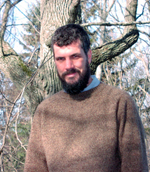American Studies' Brian Donahue talks turkey, and dishes on New England’s historical ties to the rest of the Thanksgiving meal

Brian M. Donahue
As a co-founder of Weston, Mass.-based Land’s Sake, an organization dedicated to connecting people to the land, it’s no surprise that in the classroom, associate professor of American Environmental Studies Brian M. Donahue is particularly interested in the history and prospects of human engagement with the land, especially in New England.
BrandeisNOW: Thanksgiving seems to feed right into your academic interests. What’s your take on the holiday?
Brian Donahue: Thanksgiving is usually seen as a family gathering and a celebration of the harvest, but in my mind, it’s as much about preparation for winter. It marks the time of year when you want to finish raking the leaves and make sure all your wood is stacked. It’s as much about looking forward to the difficult time ahead and how you get through it, as it is about celebrating the big fall harvest. This was a considerable problem for the native people that lived here and for the first generations of English farmers who arrived here a few centuries ago. The traditional feast meal that we know today is a culmination of what those New England Yankee farmers developed after a few generations as the kinds of foods that were going to be able to sustain their families through the winter.
When we think of the local food movement that has been growing lately, it’s interesting to think of how that addresses the question of seasonal production and what makes sense to grow here in New England and what doesn’t, and what we don’t necessarily want to abandon.
BrandeisNOW: Is Thanksgiving the holiday that lends itself the most easily to local food production when we’re talking about Massachusetts, and in a larger context, New England?
BD: It does. So many of the foods are ones that we can very easily grow here, and are our regional specialties, like cranberries. When it comes right down to it, to put together one locally produced Thanksgiving meal every year isn’t that huge of a challenge. The menu celebrates things that have very deep roots here.
BrandeisNOW: Does that include turkey, which commonly serves as the centerpiece of the menu?
BD: That’s an interesting one, actually, because at that first Thanksgiving, the turkeys that were most likely eaten were local wild turkeys that were soon hunted out but that have now reappeared in our landscape, and we see those guys running around today. But the domestic turkey that we eat at Thanksgiving is not descended from those turkeys directly. It’s actually from different turkeys that existed down in central America and in Mexico and were taken back to Europe a couple of centuries earlier by the Spanish and then spread throughout Europe and brought eventually to New England by the early English farmers who came here.
In the last few decades, like everything else in our food system, turkey farming has been industrialized and now we have turkeys, raised in confinement, that are bred for enormous breasts and so forth. But, as I mentioned before, it seems like more people today are looking for locally grown turkeys that are more heritage breeds, that have a little more flavor and maybe spent more of their lives out in the open, on pasture even. You can buy turkeys like that from local farms- we certainly do in my family. That is a food we could produce a lot more of in New England. It’s perfectly feasible for us to raise a lot more free-range turkey across our pastureland.
But even a “pastured” turkey is going to be eating mostly grain, and it’s likely that feed will be brought here from the Midwest. So maybe the turkey is a good illustration of a balanced approach to local farming and getting some things from farther away. Grain is a very sensible thing to ship long distances.
BrandeisNOW: What about other parts of the meal?
BD: Mashed potatoes are a similar story. They are something that came from South America, then went to Europe, and eventually arrived in New England around 1720 with some Scotch Irish farmers who immigrated to Londonderry, New Hampshire. They were really a godsend because you can produce a lot of starch and calories with those potatoes, and it really helped in forming an adequate winter diet. Potatoes are still something that we know how to produce a lot of in New England, and there are many new flavorful varieties coming on the market today.
BrandeisNOW: We always think of Thanksgiving as a time to be thankful for what we have; maybe we need to broaden our thinking to being thankful for the local food production that we have as well.
BD: Sure, no question about that at all. It’s a holiday that naturally ties us back to our roots, to foods that came out of New England, and that could be grown here in the future. That extends, even, to the glass of wine that many of us enjoy along with our Thanksgiving meal. With global warming, it may be that New England is going to be one of the few places in the country where wine production is still possible. That’s certainly not something to cheer about, but on the southern edges of New England, we’re beginning to see production of some really excellent wines.
BrandeisNOW: An interesting angle to an unfortunate situation. Thanks for the historical menu tour.
BD: Happy Thanksgiving.





